Media and tray
This chapter provides information on how to load print media into your machine.
|
|
|
|
|
|
|
|
The use of inflammable media or foreign materials left in the printer may lead to overheating of the unit and, in rare cases may cause a fire. |
To change the size, you need to adjust the paper guide.
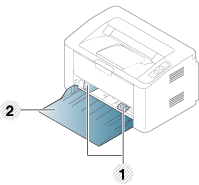
|
|
|
|
|
|
If you do not adjust the guide, it may cause paper registration, image skew, or jamming of the paper. |
-
Open the tray.
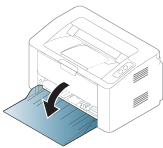
-
Flex or fan the edge of the paper stack to separate the pages before loading papers.

-
Adjust the tray size to the media size you are loading (see Tray overview). Then place the paper with the side you want to print facing up and open the output tray.
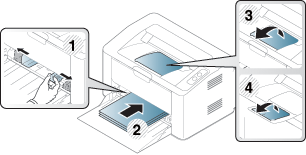
-
Squeeze the paper width guide and slide it to the edge of the paper stack without causing it to bend.
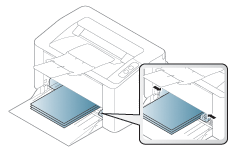
![[Note]](../../common/icon_note.png)
-
Do not push the paper width guide too far causing the media to warp.
-
If you do not adjust the paper width guide, it may cause paper jams.

-
Do not use a paper with a leading-edge curl, it may cause a paper jam or the paper can be wrinkled.

-
-
When you print a document, set the paper type and size for the tray (see Setting the paper size and type).
The manual feeder can hold special sizes and types of print material, such as postcards, note cards, and envelopes (see Print media specifications ).
|
|
|
|
Tips on using the manual feeder
|
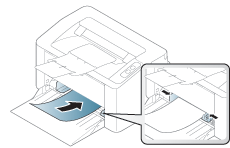
The table below shows the special media usable in tray.
The paper setting in the machine and driver should match to print without a paper mismatch error.
To change the paper setting set in the machine, from
the Samsung Easy Printer Manager select ![]() (Switch
to advanced mode)> .
(Switch
to advanced mode)> .
Then, set the paper type from the window > tab > (see Opening printing preferences).
|
|
|
|
When using special media, we recommend you feed one sheet at a time (see Print media specifications ). |
To see for paper weights for each sheet, refer to Print media specifications .
(●: Supported)
Printing successfully on envelopes depends upon the quality of the envelopes.
To print an envelope, place it as shown in the following figure.
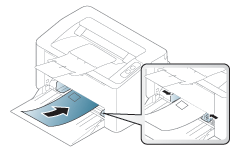
If you select from the window, but the printed images get easily erased, select and try printing again. However, this might cause some noise when printing.
-
When selecting envelopes, consider the following factors:
-
Weight: should not exceed 90 g/m2 otherwise; jams may occur.
-
Construction: should lie flat with less than 6 mm curl and should not contain air.
-
Condition: should not be wrinkled, nicked, nor damaged.
-
Temperature: should resist the heat and pressure of the machine during operation.
-
-
Use only well-constructed envelopes with sharp and well-creased folds.
-
Do not use stamped envelopes.
-
Do not use envelopes with clasps, snaps, windows, coated lining, self-adhesive seals, or other synthetic materials.
-
Do not use damaged or poorly made envelopes.
-
Be sure the seam at both ends of the envelope extends all the way to the corner of the envelope.

-
Acceptable
-
Unacceptable
-
-
Envelopes with a peel-off adhesive strip or with more than one flap that folds over to seal must use adhesives compatible with the machine’s fusing temperature for 0.1 second (about 170°C (338 °F)). The extra flaps and strips might cause wrinkling, creasing, or jams, and may even damage the fuser.
-
For the best print quality, position margins no closer than 15 mm from the edges of the envelope.
-
Avoid printing over the area where the envelope’s seams meet.
To avoid damaging the machine, use only labels designed for use in laser printers.
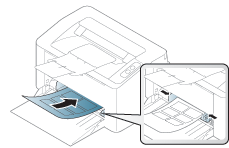
-
When selecting labels, consider the following factors:
-
Adhesives: Should be stable at your machine’s fusing temperature. Check your machine’s specifications to view the fusing temperature (about 170°C (338°F)).
-
Arrangement: Only use labels with no exposed backing between them. Labels can peel off sheets that have spaces between the labels, causing serious jams.
-
Curl: Must lie flat with no more than 13 mm of curl in any direction.
-
Condition: Do not use labels with wrinkles, bubbles, or other indications of separation.
-
-
Make sure that there is no exposed adhesive material between labels. Exposed areas can cause labels to peel off during printing, which can cause paper jams. Exposed adhesive can also cause damage to machine components.
-
Do not run a sheet of labels through the machine more than once. The adhesive backing is designed for only a single pass through the machine.
-
Do not use labels that are separating from the backing sheet or are wrinkled, bubbled, or otherwise damaged.
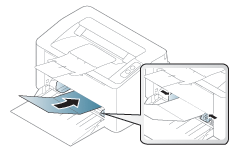
-
In the software application, set margins at least 6.4 mm (0.25 inches) away from the edges of the material.
When loading preprinted paper, the printed side should be facing up with an uncurled edge at the front. If you experience problems with paper feeding, turn the paper around. Note that print quality is not guaranteed.
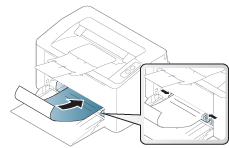
-
Must be printed with heat-resistant ink that will not melt, vaporize, or release hazardous emissions when subjected to the machine’s fusing temperature for 0.1 second (about 170°C (338°F)).
-
Preprinted paper ink must be non-flammable and should not adversely affect machine rollers.
-
Before you load preprinted paper, verify that the ink on the paper is dry. During the fusing process, wet ink can come off preprinted paper, reducing print quality.
Setting the paper size and type
After loading paper in the paper tray, set the paper size and type.
The paper setting in the machine and driver should match to print without a paper mismatch error.
To change the paper setting set in the machine, from
the Samsung Easy Printer Manager select ![]() (Switch
to advanced mode)> .
(Switch
to advanced mode)> .
Then, set the paper type from the window > tab > (see Opening printing preferences).
|
|
|
|
If you want to use special-sized paper such as billing paper, select in the tab in the (see Opening printing preferences). |

